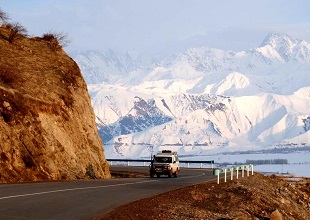
India’s Foray into Central Asia: Trade Potential and Transit Corridors
Publication: Eurasia Daily Monitor Volume: 10 Issue: 211
By:

With China promoting its own Silk Road vision in Central Asia, it seems that the New Silk Road Initiative promoted by the United States has been eclipsed. Nonetheless, there is still an opportunity for the US to promote much-needed trade relations between Central Asia and Afghanistan with India, as well as connect this region with the emerging Southeast Asian markets. Not coincidentally, then–Secretary of State Hillary Clinton first announced the New Silk Road Initiative in Chennai, India, in 2011 (https://www.state.gov/secretary/rm/2011/07/168840.htm). Increased trade with India would offer diversification and needed balance in the region, helping avoid a Chinese monopoly. But sustained trade engagement between India and Central Asia and Afghanistan—which could potentially pave the way for long-term Afghan stabilization—requires a push and commitment from the US. The latest developments in the region, however, suggest that the players concerned are still far from reaching such cooperation.
The 12th Ministerial Conference of the Central Asia Regional Economic Cooperation (CAREC) countries, funded by the Asian Development Bank (ADB), took place in Astana on October 24. ADB’s President Takehiko Nakao spoke about how Central Asia can become a transport link for the RICE countries (Russia, India, China and emerging Europe). He also stressed the need to align CAREC corridors to new routes (https://www.adb.org/news/speeches/keynote-address-president-nakao-12th-carec-ministerial-meeting). Indeed, Nakao’s CAREC conference speech described an ideal, best-case scenario for Central Asia; however, neither his organization nor any other financial body has laid out how to materialize this vision.
At The Jamestown Foundation’s October 25 New Silk Road conference in Washington, DC (more information on the conference can be found here: https://www.jamestown.org/press/events/single/?tx_ttnews[tt_news]=41506&tx_ttnews[backPid]=19&cHash=ac33f2911cf6cd4a53fd7eade88d1b300), Dr. S. Frederick Starr, Chairman of the Central Asia–Caucasus Institute and Silk Road Studies Program at Johns Hopkins–SAIS, pointed out that the CAREC road infrastructure project is missing one very important link: it is limited to road projects within Central Asia and Afghanistan and lacks transit corridors to India, one of the major cargo centers closest to the region that sits between Southeast Asian and Middle Eastern markets. Continuing this line of thought, Dr. Starr noted that the main obstacle is not financial constraint, but rather failure to develop smart strategies by bringing everyone to the same table. However, when the conference’s later speaker Craig Stephenson, ADB’s North America representative, was asked to comment on the involvement of CAREC in such inter-regional road projects, he said that the CAREC framework was designed solely to interconnect Central Asian countries and Afghanistan and had no plans for infrastructure development beyond the region. Even if ADB’s CAREC wished to pursue Central Asia’s interconnection with India, additional financial resources, which are not currently available, would be required, he added.
India’s foreign trade has been expanding considerably over the last few years, including with Central Asia. According to Evgeniy Vinokurov, of the Eurasian Development Bank’s Center for Integrated Studies, based in St. Petersburg, Russia, India’s foreign trade has been increasing at around 19 percent since the year 2000. In 2008, India earned $43 billion from exports to the European Union and almost $3 billion from exports to Northern and Central Eurasia—compared to 2000, when these numbers were $12 billion and $0.7 billion, respectively (https://www.emergingmarketsforum.org/downloads/Emerging%20Eurasia%20Aug%2020.pdf). For Central Asia and Afghanistan, the potential for trading with India, as well as transit through India to reach Southeast Asian markets, is huge and is the core of the developing North-South Corridor for trade and transit in Eurasia. Vinokurov argues that, according to predictions, the delivery time of goods traveling along the North-South Corridor would be reduced by anywhere from 10 to 20 days and that the cost per container would decrease by $400–$500, compared to the more circuitous routes through neighboring countries that are in use currently. However, due to the continued lack of infrastructure development and the availability of already established routes, freight forwarders are little interested in transit corridors through Afghanistan at the moment. If the North-South Corridor can be successfully developed, an estimated $100–120 billion worth of goods could be passing through Central Asia and Afghanistan—up to 20 percent of India’s $500–600 billion worth of trade with Europe, the Commonwealth of Independent States (CIS), Iran, Afghanistan and Pakistan (https://www.silkroadstudies.org/new/inside/publications/Joshi.html).
Infrastructure construction aside, the Central Asian republics and Afghanistan still also need to overcome serious legal, pricing, transportation and trade-procedure harmonization obstacles. The World Bank and the International Finance Corporation’s 2014 Doing Business report reveals that Central Asian countries and Afghanistan occupy the lowest levels in the Trading Across Border category, which measures the number of documents, number of days, and costs for importing and exporting goods to and from a surveyed country. The Central Asian republics and Afghanistan received rankings between 182 and 189, with Uzbekistan receiving the lowest rank of 189 out of all 189 countries surveyed. These countries clearly still have a long way to go until the region’s international trade potential is fully realized and local pricing and legal hurdles are overcome. The US State Department’s Fatema Sumar noted at the aforementioned October 24 CAREC ministerial in Astana that it takes the CAREC countries 65–90 days to export goods, as opposed to only 15 days for exports to be shipped out of India (https://iipdigital.usembassy.gov/st/english/texttrans/2013/10/20131024285158.html#axzz2j2aInG7h).
Compared to Russia and China, India’s presence in Central Asia is still marginal. However, its growing economic and energy needs (the country is consuming only about half of the natural gas its economy currently requires) will push India to keep looking for areas of cooperation with Central Asia, which so far have been underwhelming (see EDM, July 9, October 15). Nevertheless, promoting India’s cooperation within the New Silk Road Initiative and working with Central Asian countries to overcome non-infrastructure related issues, such as legal and pricing issues in border transit, is a niche that the US can exploit with potentially tremendous results. India’s greater involvement in the region would likely be welcomed by Central Asian governments to help balance China and Russia’s presence.




